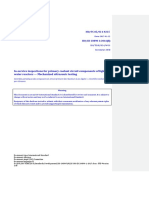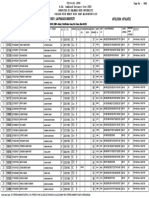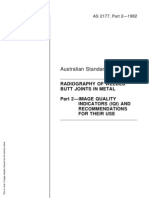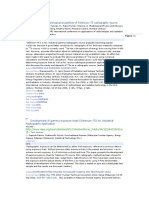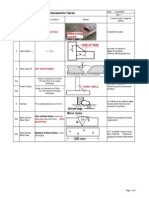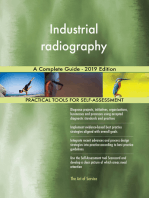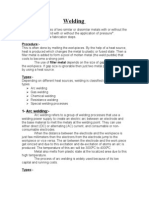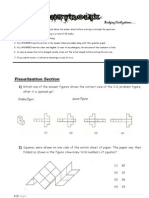Slivers
Slivers
Uploaded by
Varun MishraCopyright:
Available Formats
Slivers
Slivers
Uploaded by
Varun MishraOriginal Description:
Original Title
Copyright
Available Formats
Share this document
Did you find this document useful?
Is this content inappropriate?
Copyright:
Available Formats
Slivers
Slivers
Uploaded by
Varun MishraCopyright:
Available Formats
The Scientific Bulletin of VALAHIA University MATERIALS and MECHANICS Nr.
7 (year 10) 2012
SLIVER DEFECTS ON LOW CARBON STEELS, COLD ROLLED STRIPS
Dumitrescu A.T., Catangiu A. University Valahia of Trgovite E-mail: acatangiu@yahoo.co.uk Abstract. One definition of slivers could be: defects in the nature of irregularly shaped pieces of steel clinging loosely to finished steel. Slivers may result from defective composition (over-oxidized, high sulfur); defective teeming of molten steel; defective heating (burning); tearing of corners in early stages of rolling; etc. So, from the definition is obvious that the origin of slivers could be in different stages of steel flow route but, the main source of slivers is related to nonmetallic inclusions formed and entrapped on the subsurface of continuous cast slabs, as are FeO and Al2O3. These inclusions are generated by mould slag entrapment on solidifying shell, re-oxidation during continuous casting by air, refractory materials, ladle slag, etc.The present paper contains metallographic analysis of areas connected to slivers from 5 cold rolled coils of strips with thickness varying between 1.8mm to 4.1mm and the carbon content from 0.04% to 0.188% and in all analyzed areas have been observed only FeO inclusions related to slivers defects, inclusions formed during continuous slab casting process.
Keywords: sliver, low carbon steels, cold rolled strips
1. INTRODUCTION The quality of finished steel products is often impaired by the presence of surface defects such as slivers, cracks, laps, etc. and/or internal defects like cracks, porosity, segregation, etc. Defects in finished steel products may arise from poor steel quality (high nonmetallic inclusion content) at steel making stages or may be caused during subsequent downstream operations such as casting, reheating, hot/cold rolling or drawing. Such defects may remain undetected in intermediate processing stages and ultimately show up in the finished product during final inspection. Line defects appear on the surface of finished strip product, with several tens of micrometers to millimeter in width and 0. 1 - 1. 0 m in length slivers are irregular, flatly formed laminations of varying size and shape that occur in longitudinal direction of the strip and are distributed irregularly over the strip width (OKOF, 1996) This surface defect is believed to result from nonmetallic inclusions caught near the surface of the slab (<15 mm from the surface), coupled with elongated bubbles The inclusions can be oxide particles,casting powder, alumina clusters, refractory, etc. When the sliver defects are examined, it is found that there are different causes for an identical macroscopic form. Electron probe microanalysis (EPMA), confirmed for some cases, these inclusions to be Al2O3 that formed during steel making and surfaced during hot rolling [1] There are other slivers, which have Fe-oxide (scale) present along the lamination with an alloy enriched internal oxidation (IO) in the substrate. These solidstate re-oxidation products typically are about 1micron Table 1. Chemical composition of the coils Coil. C Mn P S A B C D E 0,04 0,034 0,04 0,188 0,106 0,24 0,28 0,26 0,56 0,35 0,019 0,015 0,013 0,018 0,01 0,007 0,007 0,007 0,0096 0,0101 Si 0,016 0,029 0,016 0,015 0,01 in diameter and are formed as a result of oxygen diffusion ahead of a scale front where they precipitate from solid solution at elevated temperatures. In carbon steels, they often are accompanied by localized decarburization[2]. While IO has been observed to occur from damage as late as the first roughing stand, since the internal oxides form at elevated temperatures they are generally believed to be an evidence of the defect present in the slab before reheating. Consequently, slivers with IO are commonly presumed to be the result open or coarse cracks on the cast slab, indicating a problem with the casting operation. A considerable share of sliver defects also has scale present along the lamination, yet, because of the absence or only weak presence of internal oxidation in the sliver region, the hot rolling stage is attributed to be the cause. However, FeO-type sliver defects can occur with or without dispersed oxides often referred to as internal oxidation[3]. Some slivers were found from mold slag entrainment, Mold fluxes not melting homogenously tend to have several phases with areas of high melting and low viscosity oxides, which are available for entrapment, Mold fluxes during strand startup do not immediately supply the necessary liquid layer essential for lubrication, and consist of a combination of dry powder, semi-molten and molten [4] Although several experiments have been conducted to establish how the defects form/evolve from slab to strip, many questions remain.
Cu 0,02 0,03 0,03 0,01 0,01
Cr 0,02 0,02 0,03 0,02 0,02
Ni 0,04 0,03 0,03 0,02 0,02
Mo 0,006 0,004 0,007 0,007 0,002
V 0,004 0,005 0,004 0,003 0,002
14
The Scientific Bulletin of VALAHIA University MATERIALS and MECHANICS Nr. 7 (year 10) 2012 manganese content between 0.26% and 0.56%. In the case of another chemical elements from strips composition the variation range is quite small. In Fig.1A-D are presented the defects on the surfaces of coils and the position for metallographic specimens cutting. So, for example for A coil, the specimens 1 and 2 have been cut transversal and 3 longitudinal with respect to the rolling direction.
2. Defects on the surface of cold rolled coil
In the present paper have been analyzed the sliver defects observed on the surface of 5 cold rolled coils of strips with thickness varying between 1.8mm to 4.1mm and width being from 1092mm to 1219mm. In the Table 1 is shown the strips chemical composition. From Table 1 it can be observed the carbon content of analyzed strips varies between 0.04% and 0.188%, a quite large variation, and the
Figure 1. Metallographic specimens cut out from tested coils The position of defects, with respect to the strip width, is different from one strip to another, consequently seems not to be related to rolls or another equipment damage, even the defects appearance is quite similar, width of 815mm and length from 70 to 100mm. After un-etched metallographic examination of specimens cut longitudinally with respect to the rolling direction it can be observed for A coil (Fig. 2),the defect consists on sub-surface iron oxides which have variable thickness (max. 26m) and are found along the surface at the depth varying in the interval: 16-23m. Figure 3. Metallographic specimens (A coil; x100) examination of etched
In Fig.4 is shown the defect zone at x500 magnification and can be seen the decarburization in the zone of defect.
Figure 2. Metallographic examination of un-etched specimens (A coil) The same defect has been observed for specimen no.2, the maximum depth being 26m. In Fig.3 the etched image of specimen no.1 shows that the defect belongs to a region without decarburization and the average grain size increases from the surface, where is 9, to 5-6 at 400m depth.
Figure 4. Metallographic specimens (A coil; x500)
examination
of
etched
In order to verify if the decarburization is related to the defect or not has been analized at the same magnification, another zone of the specimen, being observed the decarburized zone as in the Fig.4. In Fig.1B is presented the defect on the surface of B coil and the position for metallographic specimens cutting. So, the specimens 1 and 2 have been cut transversal to the rolling direction. Even the defect aspect looks like to
15
The Scientific Bulletin of VALAHIA University MATERIALS and MECHANICS Nr. 7 (year 10) 2012 the defect from Fig.1A on the metallographic analysis didn`t been observed oxydized zones inside the strip but only surface iregullarities. Consequently, we believe the defect has been removed by pickling. In Fig.1C is presented the C coils surface defect and the position of metallographic specimens cutting. The un-etched image of superficial defect shows iron oxides disposed under the strip surface at the depths which vary between 10m and 20m and defect thickness varies between 10 and 15m. The same results has been shown in Fig.5 for the specimen no.2, which is at 3cm distance from the specimen no.1.
Figure 7. Metallographic specimens (C coil; x500)
examination
of
etched
In these figure (Fig.7) can be observed a light decarburization, but only along of a one grain size depth. In Fig.1D is shown the defect on the surface of D coil and the position for cutting of metallographic specimen. From Fig.8 can be observed that the defect is similar to the previous presented and consisting of rows of iron oxides along the strip surface and at a depth of 30-40m.
Figure 5. Metallographic examination of un-etched specimens (C coil) In Fig.6 is shown the specimen no.1 from C coil in etched condition. It can be observed that the defect is discontinuous and some regions of it are connected to the surface.
Figure 8. Metallographic examination of un-etched specimens (D coil) The defect thickness varies between 20 and 36m.
Figure 6. Metallographic specimens (C coil; x100)
examination
of
etched
In Fig.7 the same defect area as in Fig.6 are presented at higher magnification. Figure 9. Metallographic examination of etched specimens (D coil; x100) In Fig.9 is shown the etched image of the specimen and can be observed the grain size variation across
16
The Scientific Bulletin of VALAHIA University MATERIALS and MECHANICS Nr. 7 (year 10) 2012 the thickness and the absence of decarburization along the iron oxides from the surface. In Fig.10 is shown the defect zone at x500 magnification and can be observed the decarburized zone over the defect.
Figure 10. Metallographic examination of etched specimens (D coil; x500) Metallographic examination at the same magnification performed over another zone of the specimen far away from the defect is shown a decarburized zone with the same depth as in Fig.10. In Fig.1E is shown the E coil surface defect. From the sample presented in this figure has been cut a metallographic specimen, cross to the defect, at 5cm from the defect tip. In Fig. 11 is presented the un-etched image of the strip cross section in the defect zone and can be observed that under the strip surface there are rows of iron oxides which thickness varies between 10 to 17m and they are at 16-27m under the strip surface.
Figure 12. Metallographic examination of etched specimens (E coil; x100) In Fig.13 the same zone as from the Fig.12 is observed at higher magnification (x500).
Figure 13. Metallographic examination of etched specimens (D coil; x500) At this magnification can be observed that the iron oxides are connected to the surface by very fine cracks, which cross the grains, parallel to the specimen surface. Over this crack is observed a light decarburization.
3. CONCLUSIONS: Figure 11. Metallographic examination of un-etched specimens (E coil) In Fig.12 is shown the etched image of the cross section through the strip in the defect zone and can be observed the fine granulation of this strip, 10-11. The metallographic analysis of 5 samples from 5 different coils showed clear deffect evidences into 4 samples. The sample from the coil B has no defect, no matter the surface aspect incriminated its presence. Surface roughness variation may explain the surface aspect. Probably, the defect has been removed by pickling. In all 4 samples with defects, rows consisting of iron oxides, deformed in the rolling direction, (whose depth beneath the surface varies between 10 and 40m) have been found. The average oxides depth, for each analyzed strip, was 20m . The oxides thickness varies between 10 to 40m.
17
The Scientific Bulletin of VALAHIA University MATERIALS and MECHANICS Nr. 7 (year 10) 2012 The presence of iron oxide clearly indicates that no other inclusions of any kind are defect connected. Even the macroscopic aspect of the defects on one coil to another is quite different, the source of iron oxide should be connected with slab preexisting defect subjected to furnace atmosphere during slab reheating and less probable to a defect induced into slab surface during rolling and oxidation occurring in the same process, because the defect position across the width is different for one coil to another. The decarburization is not connected to the defect presence, being observed also in another surface zones, far from the defect and the presence of decarburized areas on the strip surface, even in the slivers zones, is a suplementary argument for the prexistence of defects during the rolling process.
4. REFERENCES:
[1].P. Zahumensky, M. Merwin, Evolution of artificial defects from slab to rolled products, Journal of materials processing technology 1 9 6 (2 0 0 8 ) 266278. [2].Weihua Sun, A.K. Tieu, Zhengyi Jiang, Cheng Lu, High temperature oxide scale characteristics of low carbon steel in hot rolling, Journal of Materials Processing Technology 155 156 (2004) 13071312. [3]. Zhang Li-feng, Inclusion and Bubble in Steel- A Review, Journal, of Iron and Steel Research, International,. 3 ( 3 ) (2006), 01-08. [4].Hiroshi Utsunomiya, Shoichi Doi, Ken-ichiro Hara, Tetsuo Sakai, Shusuke Yanagi, Deformation of oxide scale on steel surface during hot rolling, CIRP Annals - Manufacturing Technology 58 (2009) 271274
18
You might also like
- EN 4179and NAS 410 FILE FinalDocument7 pagesEN 4179and NAS 410 FILE FinalSURESHNo ratings yet
- Reviews of ACFMDocument7 pagesReviews of ACFMNILESHNo ratings yet
- Fir-001 - 10 03 18Document1 pageFir-001 - 10 03 18Kartik SolankiNo ratings yet
- Microwave Scanning Technology For Mate-Rial Testing: ECNDT 2006 - Th.4.2.2Document8 pagesMicrowave Scanning Technology For Mate-Rial Testing: ECNDT 2006 - Th.4.2.2TinhVoNo ratings yet
- ISO-TC135-SC5 N0220 New Standards On Digital Industrial RadiologyDocument52 pagesISO-TC135-SC5 N0220 New Standards On Digital Industrial RadiologyHappy2021No ratings yet
- Pentrmeter SpecificationDocument30 pagesPentrmeter SpecificationJayeshNo ratings yet
- Radiography: J K Singh Lecturer/EMDocument33 pagesRadiography: J K Singh Lecturer/EMmanoj kumarNo ratings yet
- E-PROC-ENG-BI-111 Rev 007Document32 pagesE-PROC-ENG-BI-111 Rev 007Jonicus-DextoreNo ratings yet
- Ultrasonic Testing of Tube To Tube SheetDocument6 pagesUltrasonic Testing of Tube To Tube SheetDARSHIL RAJPURANo ratings yet
- Welding ProcessDocument29 pagesWelding ProcessKoon AnuNo ratings yet
- Nuclear UT - ISO - CD - 20890-1-2017Document39 pagesNuclear UT - ISO - CD - 20890-1-2017Anonymous 5qPKvmuTWCNo ratings yet
- AGFA G135 Dev Part A MSDS v1Document10 pagesAGFA G135 Dev Part A MSDS v1RenewiNo ratings yet
- Ch.22 - Digital RadiographyDocument23 pagesCh.22 - Digital Radiographydawadhali100% (1)
- Astm A751 21Document5 pagesAstm A751 21Chenjie Zhu100% (1)
- En 14096-1 Final DraftDocument11 pagesEn 14096-1 Final Draftrizwankhanzhi100% (1)
- ASTM A 153 Zinc Coating On Iron and Steel HardwareDocument2 pagesASTM A 153 Zinc Coating On Iron and Steel Hardwarevelmurug_balaNo ratings yet
- Digital RadiographyDocument35 pagesDigital RadiographyAhmed shabanNo ratings yet
- Re: RT Sensitivity Calculation: Use of Multi FilmDocument2 pagesRe: RT Sensitivity Calculation: Use of Multi FilmravindevNo ratings yet
- Material Selection: Process & Process Selections: Materials Selection and Design EBT 447 SEMESTER I, 2014/2015Document38 pagesMaterial Selection: Process & Process Selections: Materials Selection and Design EBT 447 SEMESTER I, 2014/2015fatinzalilaNo ratings yet
- Training - Air Arc GougingDocument21 pagesTraining - Air Arc GougingmukeshayoorNo ratings yet
- PCN Institute NamesDocument12 pagesPCN Institute NamesGanesh SekarNo ratings yet
- Techniques and Standarts For Measuring Ferrite in Austenitic Stainless Steel WeldsDocument6 pagesTechniques and Standarts For Measuring Ferrite in Austenitic Stainless Steel WeldslkarolinoNo ratings yet
- Paut Paper PDFDocument7 pagesPaut Paper PDFAyesha Ge100% (1)
- Rtfi Notes 4Document22 pagesRtfi Notes 4Ajith PayyanurNo ratings yet
- A Study On Low Magnetic PermeabilityDocument28 pagesA Study On Low Magnetic PermeabilitymishikhanNo ratings yet
- The Effect of CarbonDocument4 pagesThe Effect of CarbonkingstonNo ratings yet
- Ewert WCNDT Standards 2012 04Document38 pagesEwert WCNDT Standards 2012 04bladdeeNo ratings yet
- RT Pipeline Crawler PDFDocument12 pagesRT Pipeline Crawler PDFAnonymous 5qPKvmuTWCNo ratings yet
- Standard Practice For Secondary Calibration of Acoustic Emission SensorsDocument8 pagesStandard Practice For Secondary Calibration of Acoustic Emission SensorsArpan NandyNo ratings yet
- OIL & GAS: Qa/QcDocument20 pagesOIL & GAS: Qa/QcSurjit DuttaNo ratings yet
- Why Use Preheat and Post Weld Heat Treatments Brochure PDFDocument2 pagesWhy Use Preheat and Post Weld Heat Treatments Brochure PDFErick HoganNo ratings yet
- SG Tube Inspection TechnologyDocument9 pagesSG Tube Inspection TechnologyWaqasNo ratings yet
- RTFI Assessment Presentation 5-23-05Document185 pagesRTFI Assessment Presentation 5-23-05Ahmed shabanNo ratings yet
- CW1Document6 pagesCW1phutd09No ratings yet
- WeldingDocument21 pagesWeldingprabhatkumar_6657012No ratings yet
- 096 SelDocument3 pages096 SelPiyush SrivastavaNo ratings yet
- Asnt MTDocument310 pagesAsnt MTpakostralNo ratings yet
- Another Look at Visual InspectionDocument17 pagesAnother Look at Visual InspectionwaheedNo ratings yet
- IQI DinDocument14 pagesIQI DinMaria Louis ArputharajNo ratings yet
- Selenium 75Document5 pagesSelenium 75jimmy david espinoza mejiaNo ratings yet
- YXLON MU2000 D With CTDocument8 pagesYXLON MU2000 D With CTXuân Đài 5.0 (xuandai.,ltd)No ratings yet
- Modes of Heat Transfer PresentationDocument12 pagesModes of Heat Transfer PresentationYashvir SinghNo ratings yet
- 008a.rtfi - AbbrevationsDocument2 pages008a.rtfi - AbbrevationsVivekanandan JNo ratings yet
- Holiday Detection in Pipeline Coatings: Standard Test Methods ForDocument4 pagesHoliday Detection in Pipeline Coatings: Standard Test Methods ForAlejandro ValdesNo ratings yet
- Standard Keur 00820-702: 1 Scope and Field of Application 1.1 ScopeDocument6 pagesStandard Keur 00820-702: 1 Scope and Field of Application 1.1 ScopeEsin DenizNo ratings yet
- John Thompson Boiler Development and Training CentreDocument2 pagesJohn Thompson Boiler Development and Training CentreMohit ComputerNo ratings yet
- Continuous Grain Flow Forged Carbon and Alloy Steel Crankshafts For Medium Speed Diesel EnginesDocument5 pagesContinuous Grain Flow Forged Carbon and Alloy Steel Crankshafts For Medium Speed Diesel EnginesAli Saleh Saad AL-isawiNo ratings yet
- High Voltage Porosity2Document14 pagesHigh Voltage Porosity2Alejandro EstremadoyroNo ratings yet
- SafeRad PresentationDocument280 pagesSafeRad PresentationNajib BaharudinNo ratings yet
- Liquid Penetrant Test Procedure: Document No.: SP-1.5 Rev. 1.2Document12 pagesLiquid Penetrant Test Procedure: Document No.: SP-1.5 Rev. 1.2Anas PratamaNo ratings yet
- Is 7743Document9 pagesIs 7743acro lnrNo ratings yet
- Course Notes RT Level 1 Rev 29 3a 07 2006Document470 pagesCourse Notes RT Level 1 Rev 29 3a 07 2006ravi00098100% (2)
- ASTM C-1306 - Standard Method For Hydrostatic Pressure Resistance of A Liquid-Applied Waterproofing Membrane PDFDocument3 pagesASTM C-1306 - Standard Method For Hydrostatic Pressure Resistance of A Liquid-Applied Waterproofing Membrane PDFLeonardo Otto CoutinhoNo ratings yet
- Welding Standard Ver1Document4 pagesWelding Standard Ver1Sowmen ChakrobortyNo ratings yet
- A Microwave Welding Process: An OverviewDocument5 pagesA Microwave Welding Process: An OverviewTanuj Singh Chauhan100% (1)
- Challenges in Corrosion: Costs, Causes, Consequences, and ControlFrom EverandChallenges in Corrosion: Costs, Causes, Consequences, and ControlNo ratings yet
- Sliver Defects On Low Carbon Steels, Cold Rolled StripsDocument5 pagesSliver Defects On Low Carbon Steels, Cold Rolled StripsAbhishek RajputNo ratings yet
- Project Management Workbook and PMP CAPM Exam Study GuideDocument33 pagesProject Management Workbook and PMP CAPM Exam Study GuideshetupucNo ratings yet
- Business Statistics - Retail CASE (Solutions)Document5 pagesBusiness Statistics - Retail CASE (Solutions)Anonymous 7apeurNo ratings yet
- Arithmetic OperatorsDocument2 pagesArithmetic Operatorsicul1No ratings yet
- Welding Assignment-Submitted by Fatima Fayyaz-PID-09Document4 pagesWelding Assignment-Submitted by Fatima Fayyaz-PID-09api-19753215No ratings yet
- Visualization Section: 1) Which One of The Answer Figures Shows The Correct View of The 3-D Problem FigureDocument6 pagesVisualization Section: 1) Which One of The Answer Figures Shows The Correct View of The 3-D Problem FigureBibhuti B. BhardwajNo ratings yet
- Lesson 1Document5 pagesLesson 1JänMënärd Dônqûîllô Ōrāyē SāngālNo ratings yet
- The New Biomassters - Synthetic Biology and The Next Assault On Biodiversity and LivelihoodsDocument84 pagesThe New Biomassters - Synthetic Biology and The Next Assault On Biodiversity and LivelihoodsETC GroupNo ratings yet
- Cyberbullying PaperDocument8 pagesCyberbullying PaperAlerie SalvadorNo ratings yet
- 16CS3123-Java Programming Course File-AutonomousDocument122 pages16CS3123-Java Programming Course File-AutonomousSyed WilayathNo ratings yet
- Beam Design SteelDocument116 pagesBeam Design SteelMustafa Al BacteriusNo ratings yet
- SS 1 & 2 Heat Load CalculationDocument4 pagesSS 1 & 2 Heat Load CalculationPramod B.WankhadeNo ratings yet
- Siebel CRM 100 SuccessDocument209 pagesSiebel CRM 100 Successhans_106No ratings yet
- MPX Magnetostrictive Level Sensors User Manual: For The MPX-FDocument40 pagesMPX Magnetostrictive Level Sensors User Manual: For The MPX-FFaisalNo ratings yet
- B.Tech. - EIE - R13 - Syllabus PDFDocument109 pagesB.Tech. - EIE - R13 - Syllabus PDFhemanthbbcNo ratings yet
- Betriebsanleitung Kolbenspeicheranlage EnglischDocument35 pagesBetriebsanleitung Kolbenspeicheranlage EnglischJozmel Blancas CamarenaNo ratings yet
- Mitsubishi PG CardDocument42 pagesMitsubishi PG CardDung NguyenvanNo ratings yet
- Module 5 - Fire Pump SelectionDocument41 pagesModule 5 - Fire Pump SelectionegrtacnengNo ratings yet
- 11 12 Storypitch CalixtroDocument2 pages11 12 Storypitch CalixtroPaulineArianaNo ratings yet
- Practical Guide in Local Science FairsDocument57 pagesPractical Guide in Local Science Fairsleomille2100% (2)
- Mecorrel2 - Thermo-Fluids Terminology PDFDocument13 pagesMecorrel2 - Thermo-Fluids Terminology PDFJohn Paul EspañoNo ratings yet
- P.No. Item Code Description Material THK/ Sch. Size 1 Size 2 Size 3 Size 4 Type Qty. Total Qty. Total Wt. Sub-Group WT. (KG.)Document8 pagesP.No. Item Code Description Material THK/ Sch. Size 1 Size 2 Size 3 Size 4 Type Qty. Total Qty. Total Wt. Sub-Group WT. (KG.)GauravNo ratings yet
- Установка ТНВД 2.9 3.6Document19 pagesУстановка ТНВД 2.9 3.6bogdanmichaelNo ratings yet
- E12-X01 - 0 Batteries, Racks & Batteries Chargers Data SheetDocument2 pagesE12-X01 - 0 Batteries, Racks & Batteries Chargers Data SheetMuhammad IrfanNo ratings yet
- Mast Installation Instructions: TruckDocument9 pagesMast Installation Instructions: TruckChristian BedoyaNo ratings yet
- Status of Operation: First Laguna Electric Cooperative, IncDocument13 pagesStatus of Operation: First Laguna Electric Cooperative, IncRamil F. De JesusNo ratings yet
- Raspberry Pi IOTDocument19 pagesRaspberry Pi IOTSushanth KengunteNo ratings yet
- Caster PDFDocument2 pagesCaster PDFRatko KečaNo ratings yet
- Zobel 1988 PDFDocument6 pagesZobel 1988 PDFMarcio BalestriNo ratings yet
- Walter H. SchottkyDocument3 pagesWalter H. SchottkyAmol VedpathakNo ratings yet
- Post Visit Report FormDocument8 pagesPost Visit Report FormtoddopoliNo ratings yet










